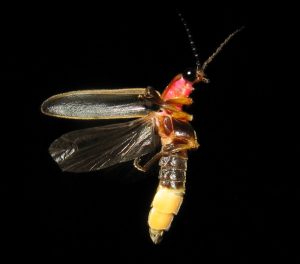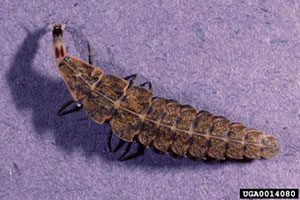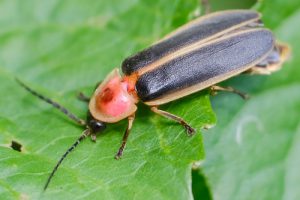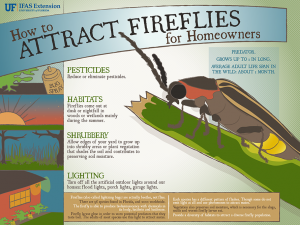
An adult firefly showing off its characteristic beetle wings and bioluminescent abdomen. Credit: Art Farmer, Creative Commons.
Many of us have memories of warm summer nights watching fireflies. Some of us might have even chased and caught a few to put in mason jars for observation, fascinated by their glowing abdomens. Floridians have the best chance to see these unique insects, as we have more known species than any other state. Recently, I’ve had many folks say that they see less fireflies these days, which got me looking into how these creatures live and what researchers know about their numbers.
Fireflies are actually a type of beetle in the Lampyridae family. They go through complete metamorphosis, meaning their immature larvae look completely different than the adults. A very unique characteristic of the family is the ability to produce light, known as bioluminescence. They do this in a very efficient way, creating very little heat, through the reaction of luciferin and luciferase along with oxygen, some energy, and other compounds. These light-producing compounds serve a dual purpose, warding off predators and attracting mates. The larvae of all Lampyridae benefit from the offensive taste of the compounds while only some adult Lampyridae use bioluminescence to attract mates. Each species of firefly has specific patterns of flashes. Males have the showiest light displays while females use more conservative light shows to signal back to potential mates.

Firefly larvae taste bad to predators due to the compounds that produce light. Credit: Gerald J Lenhard, LSU, bugwood.org.
Larvae of fireflies live in the soil and feed on slugs, snails, earthworms, and other soft-bodied insects. The larvae develop in the soil during cooler months, preferring moist habitats, and emerge as adults in the late spring to early summer. Some species may emerge in the early spring. Adult fireflies feed on nectar and honeydew, though some females prey on smaller firefly species by fooling males close to them through light signaling. Adults with the ability to produce light are active at night, while non-bioluminescent adults are active during the day.
Entomologists specializing in fireflies have raised the concern that these classic summer-time insects are in decline. Reasons for the decline are associated with increased urbanization. Loss of suitable habitat and increased pesticide use, including broad-spectrum insecticides for home lawn insect control, negatively affect firefly larvae living in the soil. Researchers also point to urban light pollution as another cause. The ever-glowing night sky in populated areas, originating from house lights, ball fields, parking lots, and roadways, disturb firefly communication and reproduction.
Homeowners can help fireflies by leaving small patches of unmanaged landscaped areas, such as along property lines, and only using insecticides when absolutely necessary. If pesticides are needed to control lawn and garden pests, the use of more selective, low-toxicity products is preferable. Turning off unnecessary outdoor lighting is another step homeowners can take to encourage firefly populations. Residents of homeowner associations can work together to minimize excess lighting community-wide, saving electricity and maybe even fireflies.
For more information on fireflies and best practices to control lawn and garden pests, contact your local county extension office.
- Tiny Invaders - February 15, 2024
- Bird Feeder Surprises - January 11, 2024
- Storm Cleanup an Opportunity for Practicing Florida Friendly Landscaping Principles - September 7, 2023


